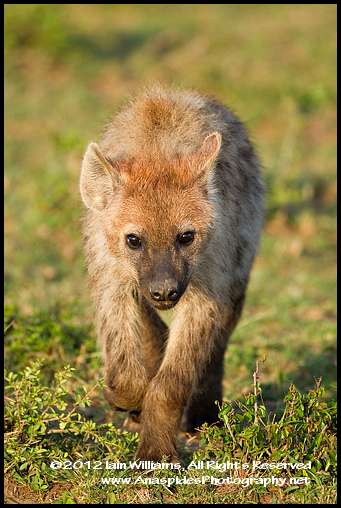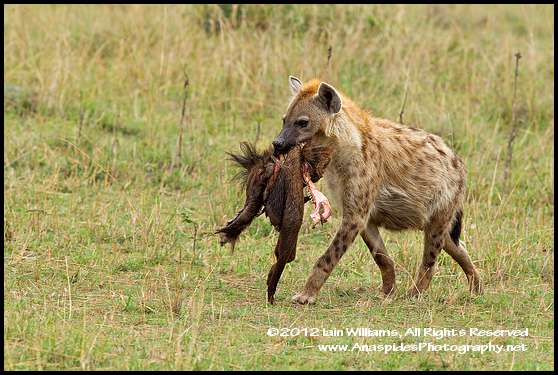Spotted Hyenas, Kenya - East Africa
 Saturday, February 4, 2012 at 2:45PM
Saturday, February 4, 2012 at 2:45PM  Continuing with the African theme. Despite vehicle issues and occasional appalling weather conditions, wildlife was plentiful.
Continuing with the African theme. Despite vehicle issues and occasional appalling weather conditions, wildlife was plentiful.
Whilst tracking cheetahs, I had observed a number of spotted hyenas and was keen to photograph some of the hyena behaviour at a den. Finding a den isn’t that difficult if you have an off-road access permit; we were driving long distances daily and we already knew the location of three hyena dens.
LEFT: An adolescent spotted hyena walks toward the camera.
Order Carnivora / Family Hyaenidae - Hyenas
The family Hyaenidae consists of three species; each living within a broad habitat range within Continental Africa. The smaller and shy brown hyena (Hyaena brunnea) occurs only in southern Africa and the Spotted Hyena (Crocuta crocuta) and the rarer Striped Hyena (Hyaena hyaena) inhabit East Africa.
Although the spotted hyena is not endangered – its numbers are actually increasing due to the decline in African wild dogs numbers, research is still conducted my scientists interested in hyena behaviour and population distribution. Although not commonplace, you see the odd hyena sporting a fashion accessory in the name of research: a tracking collar that emits either a GPS location or a radio transmission beep so researchers can track the individual.
Social Behaviour
The spotted hyena is the most social of the Hyaenidae in that it has the largest group sizes and most complex social behaviours. Its social organisation is unlike that of any other Carnivore, bearing closer resemblance to that of primates (baboons and macaques) with respect to group-size, hierarchical structure, and frequency of social interaction among both kin and unrelated group-mates. However, the social system of the spotted hyena is openly competitive rather than cooperative, with access to kills, mating opportunities and the time of dispersal for males depending on the ability to dominate other clan-members. Females provide only for their own cubs rather than assist each other, and males display no paternal care. Spotted hyena society is matriarchal; females are larger than males, and dominate them.
 A Highly Successful Animal
A Highly Successful Animal
The spotted hyena is a highly successful animal, being the most common large carnivore in Africa. Its success is due in part to its adaptability, cunning and opportunism; it is both an efficient hunter and a scavenger, with the capacity to eat and digest skin, bone and other animal waste.
LEFT: A spotted hyena carries the mane and mandible of a recently brought down and killed wildebeest.
In functional terms, the spotted hyena makes the most efficient use of animal matter of all African carnivores. The spotted hyena displays greater plasticity in its hunting and foraging behaviour than other African carnivores; it hunts alone, in small parties of 2-5 individuals or in large groups. During a hunt, spotted hyenas often run through ungulate herds in order to select an individual to attack. Once selected, their prey is chased over long distance, often several kilometers, at speeds of up to 60 km/h.
I witnessed several occasions when a pack of hyenas attempted to separate a young wildebeest from its mother, and I have a fond memory of a pack of ten hyenas trotting over a rise on a hill at dawn after a night’s long-range hunting patrol.
I my next post, we will look at the mating rituals of the spotted hyena, delve a little deeper into their complex social behaviour and have a look at hyena pups within the den.


